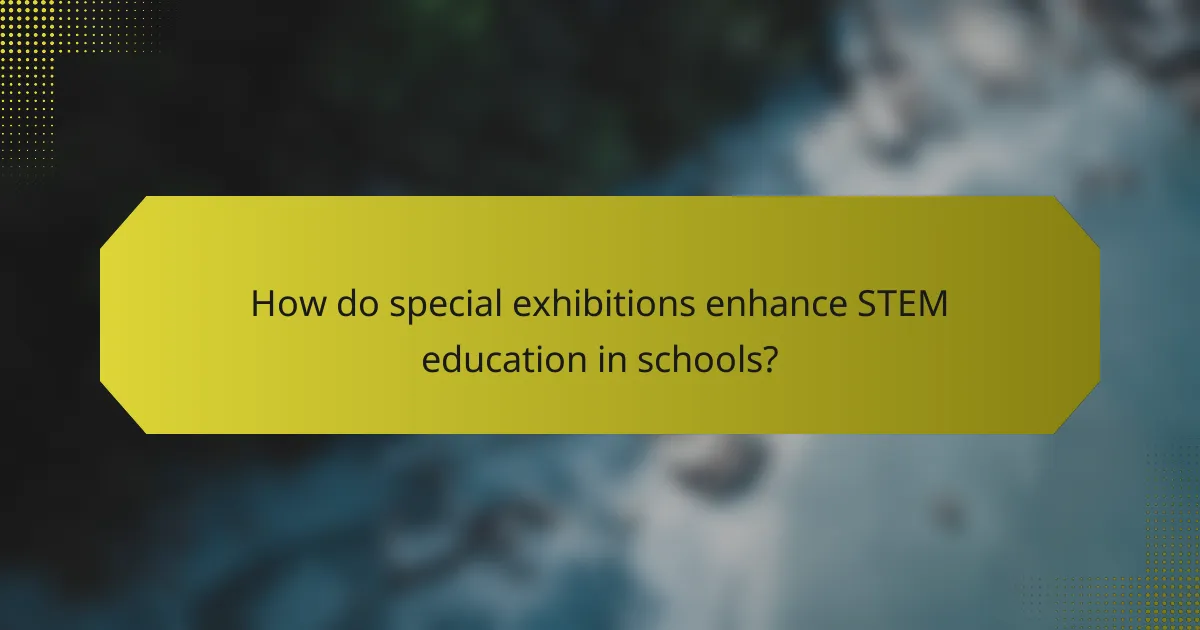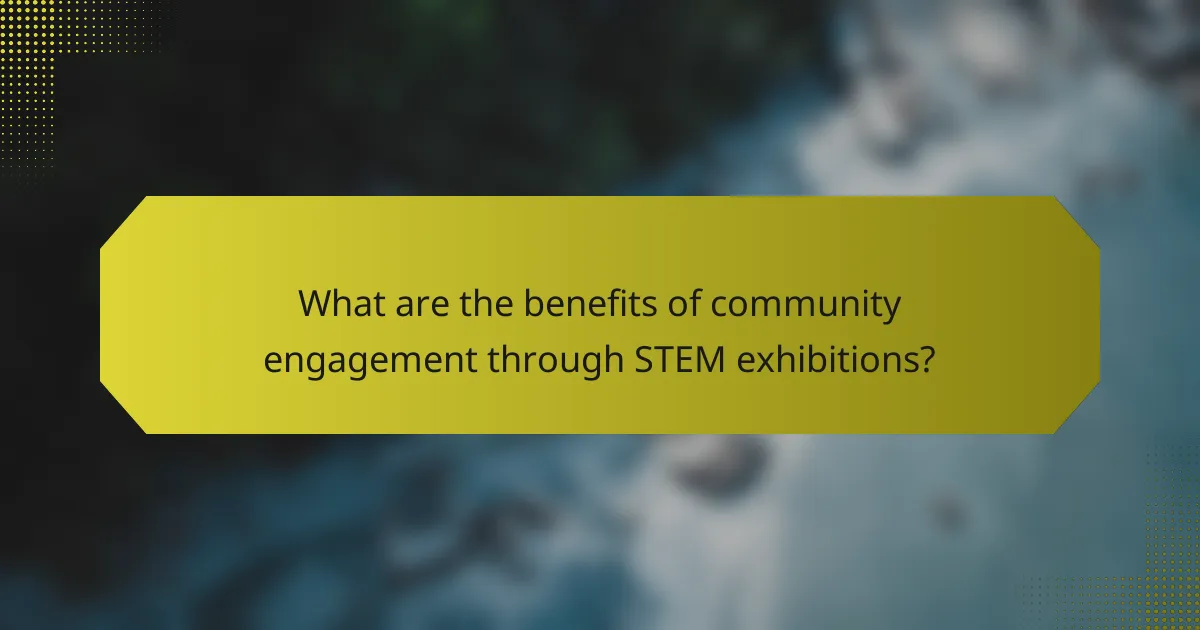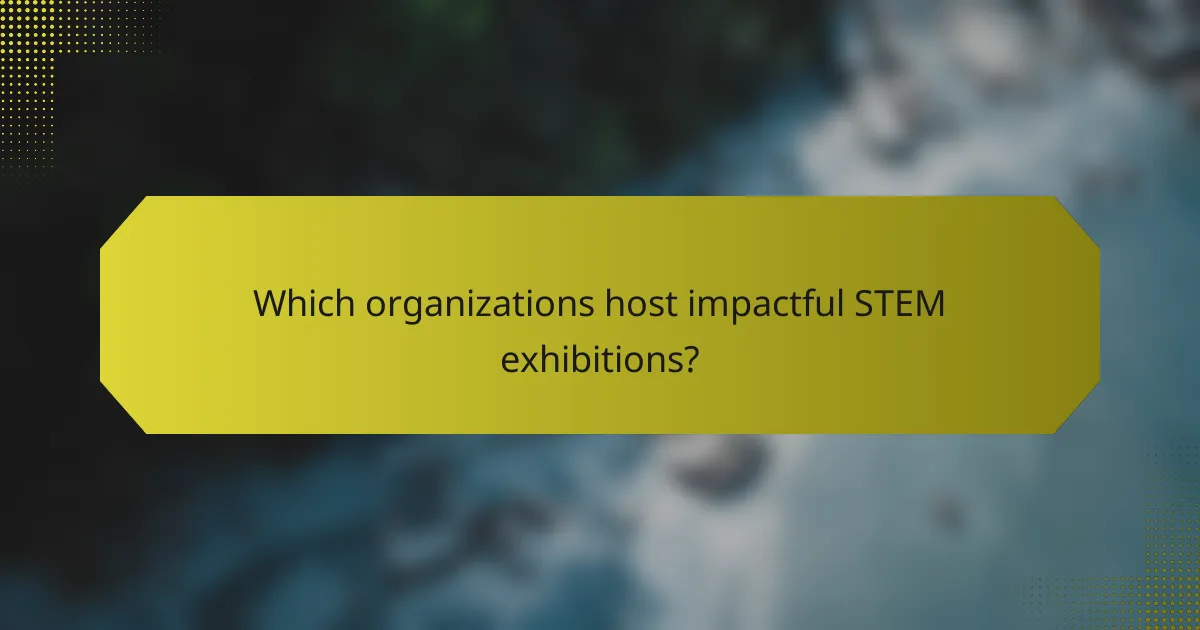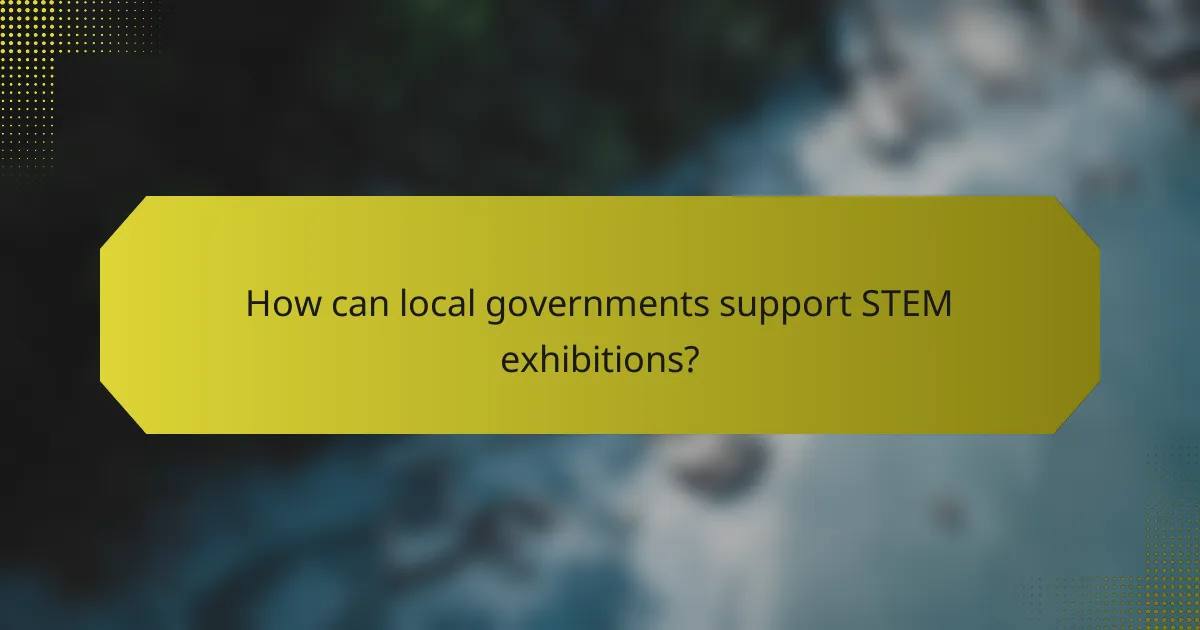Special exhibitions play a crucial role in enhancing STEM education by offering immersive and interactive experiences that captivate students and make complex scientific concepts more relatable. By fostering curiosity and critical thinking, these exhibitions not only enrich educational opportunities but also strengthen community engagement, connecting diverse groups through shared interests in science, technology, engineering, and mathematics.

How do special exhibitions enhance STEM education in schools?
Special exhibitions enhance STEM education in schools by providing immersive and interactive experiences that engage students in scientific concepts. These exhibitions foster curiosity and critical thinking, making complex ideas more accessible and relatable.
Interactive learning experiences
Interactive learning experiences allow students to engage directly with STEM content, often through hands-on activities and simulations. For example, a robotics exhibition might let students program a robot to complete tasks, reinforcing programming concepts through practical application.
These experiences can include digital interfaces, augmented reality, and physical models, all designed to stimulate interest and understanding. Schools can incorporate these elements into their curriculum to create a more dynamic learning environment.
Collaboration with local educators
Collaboration with local educators is crucial for maximizing the impact of special exhibitions on STEM education. Educators can work alongside exhibition organizers to tailor content that aligns with curriculum standards and student needs.
Such partnerships can lead to workshops and training sessions for teachers, equipping them with new strategies and resources to integrate exhibition themes into their classrooms effectively. This collaboration ensures that the learning extends beyond the exhibition itself.
Hands-on workshops and demonstrations
Hands-on workshops and demonstrations provide students with practical experiences that reinforce theoretical knowledge. These sessions often involve experiments, building projects, or using scientific tools, allowing students to see STEM principles in action.
For instance, a chemistry exhibition might include a workshop where students conduct simple experiments, fostering a deeper understanding of chemical reactions. These activities can be designed to accommodate various age groups and skill levels, ensuring inclusivity.
Real-world applications of STEM concepts
Real-world applications of STEM concepts are highlighted in special exhibitions, showing students how science, technology, engineering, and mathematics are used in everyday life. This relevance helps students connect classroom learning to real-world scenarios.
Exhibitions might showcase innovations in renewable energy, robotics, or medical technology, illustrating how STEM fields contribute to solving global challenges. By presenting these applications, students can better appreciate the importance of their studies.
Increased student engagement
Increased student engagement is a significant benefit of special exhibitions, as they often spark curiosity and enthusiasm for STEM subjects. Engaging environments encourage students to ask questions and explore topics more deeply.
To maintain this engagement, schools should encourage follow-up activities, such as projects or discussions, that allow students to reflect on their experiences. This continued interaction with the material can lead to improved academic performance and a lasting interest in STEM fields.

What are the benefits of community engagement through STEM exhibitions?
Community engagement through STEM exhibitions fosters collaboration, enhances educational opportunities, and builds a stronger local identity. These exhibitions not only provide hands-on learning experiences but also connect diverse groups, promoting shared interests in science, technology, engineering, and mathematics.
Strengthened community partnerships
STEM exhibitions create a platform for local organizations, schools, and businesses to collaborate effectively. By working together, these entities can share resources, knowledge, and expertise, leading to innovative projects and initiatives that benefit the community.
For example, a local university might partner with a nearby school to host an exhibition, allowing students to showcase their projects while gaining mentorship from university faculty. This not only enhances educational outcomes but also strengthens ties within the community.
Increased public interest in STEM fields
Engaging the community through STEM exhibitions can significantly boost interest in STEM careers among attendees. Interactive displays and hands-on activities make complex subjects more accessible and enjoyable, inspiring participants to explore further education and career opportunities in these fields.
Local events can attract families, students, and professionals, creating a vibrant atmosphere that encourages discussions about STEM topics. This heightened interest can lead to increased enrollment in STEM-related programs at local schools and colleges.
Opportunities for local businesses
STEM exhibitions provide local businesses with unique opportunities to showcase their products and services. By participating in these events, companies can connect with potential customers, demonstrate their commitment to community development, and highlight their role in advancing STEM education.
For instance, a tech company might sponsor a robotics competition at a STEM exhibition, gaining visibility while supporting local talent. Such involvement can lead to increased sales and foster long-term customer loyalty, benefiting both the business and the community.

Which organizations host impactful STEM exhibitions?
Several organizations are known for hosting impactful STEM exhibitions that enhance education and community engagement. These institutions create interactive experiences that inspire curiosity and promote learning in science, technology, engineering, and mathematics.
Smithsonian Institution
The Smithsonian Institution, located in Washington, D.C., is renowned for its extensive collection of museums and research facilities. Its exhibitions often focus on innovative scientific discoveries and historical advancements, making STEM accessible and engaging for all ages.
Visitors can explore hands-on exhibits that cover topics from space exploration to environmental science. Programs like the Smithsonian Science Education Center provide resources for educators to integrate STEM into their curricula effectively.
California Science Center
The California Science Center in Los Angeles offers a variety of interactive exhibits that emphasize the importance of science in everyday life. Its mission is to inspire a passion for science and technology through engaging experiences.
One of its notable attractions is the Space Shuttle Endeavour, which draws significant interest and serves as a catalyst for discussions about aerospace engineering and technology. The center also hosts workshops and events aimed at fostering STEM learning in the local community.
Exploratorium in San Francisco
The Exploratorium in San Francisco is a unique museum that focuses on hands-on learning through interactive exhibits. It encourages visitors to explore scientific concepts through play and experimentation, making it a leader in informal STEM education.
With over 600 exhibits, the Exploratorium covers a wide range of topics, from physics to biology. Its programs often include workshops and community events that promote collaboration and creativity in STEM fields, making it a vital resource for educators and families alike.

How can local governments support STEM exhibitions?
Local governments can enhance STEM exhibitions by providing financial support, promoting events, and collaborating with educational institutions. These actions not only foster community engagement but also improve educational outcomes in science, technology, engineering, and mathematics.
Funding and grants for educational programs
Local governments can allocate budgets or create grant programs specifically for STEM exhibitions. This funding can cover venue costs, materials, and personnel, making it easier for organizations to host events that engage the community.
Consider establishing partnerships with local businesses or educational foundations to supplement funding. These collaborations can enhance the financial resources available and create a shared interest in promoting STEM education.
Promotion of events through local channels
Effective promotion is crucial for the success of STEM exhibitions. Local governments can utilize community newsletters, social media platforms, and public bulletin boards to spread the word about upcoming events.
Engaging local media outlets for coverage can also increase visibility. Consider hosting press events or providing press releases to generate interest and attract a larger audience.
Collaboration with educational institutions
Partnering with schools, colleges, and universities can significantly enhance the quality and reach of STEM exhibitions. Educational institutions can provide expertise, resources, and volunteers to support event planning and execution.
Establishing regular communication with local educators can help identify community needs and interests, ensuring that exhibitions are relevant and beneficial. This collaboration can also lead to ongoing programs that sustain interest in STEM beyond individual events.

What criteria should be considered when selecting a STEM exhibition?
When selecting a STEM exhibition, consider factors such as alignment with local educational standards, accessibility for various audience demographics, and the quality of interactive experiences offered. These criteria ensure that the exhibition effectively engages the community and enhances educational outcomes.
Relevance to local curriculum
The exhibition should align closely with the local curriculum to maximize its educational impact. This means incorporating topics and skills that are currently being taught in schools, such as robotics, environmental science, or mathematics. Engaging educators during the selection process can help identify key areas of focus.
For example, if local schools emphasize hands-on learning in science, an exhibition featuring interactive experiments in chemistry or physics would be highly relevant. Additionally, ensuring that the exhibition addresses state or national educational standards can further enhance its effectiveness.
Accessibility for diverse audiences
Accessibility is crucial for ensuring that all community members can engage with the exhibition. This includes physical access for individuals with disabilities, as well as offering materials in multiple languages and formats. Consideration of different learning styles and age groups can also enhance inclusivity.
For instance, providing sign language interpreters or guided tours for visually impaired visitors can make a significant difference. Additionally, offering online resources or virtual tours can extend access to those unable to attend in person, broadening the exhibition’s reach.
Quality of interactive content
The quality of interactive content is vital for maintaining visitor engagement and facilitating learning. High-quality exhibits should encourage hands-on participation, critical thinking, and problem-solving. Look for exhibitions that incorporate technology, such as augmented reality or interactive simulations, to enhance the learning experience.
When evaluating potential exhibitions, consider the depth of the interactive elements. Simple demonstrations may be less effective than immersive experiences that allow visitors to experiment and explore concepts in a meaningful way. Collecting feedback from previous attendees can also provide insights into the effectiveness of the interactive components.

How do special exhibitions foster STEM career exploration?
Special exhibitions play a crucial role in fostering STEM career exploration by providing immersive experiences that connect attendees with real-world applications of science, technology, engineering, and mathematics. These exhibitions often feature interactive displays, hands-on activities, and opportunities to engage with industry professionals, making STEM fields more accessible and appealing to diverse audiences.
Networking opportunities with professionals
Special exhibitions create valuable networking opportunities with professionals in STEM fields. Attendees can meet scientists, engineers, and educators who share insights about their careers and the skills required for success. This direct interaction can inspire individuals to pursue specific paths within STEM.
Many exhibitions include panel discussions, workshops, and Q&A sessions where participants can ask questions and gain advice on career development. Engaging with professionals can help attendees understand the various roles available in STEM and the educational pathways that lead to those careers.
To maximize networking benefits, attendees should prepare questions in advance and actively participate in discussions. Following up with contacts made during the exhibition can also lead to mentorship opportunities or internships, further enhancing career exploration in STEM.


